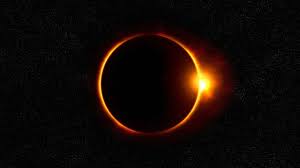First Solar Eclipse of 2025: Everything You Need to Know
Introduction to the First Solar Eclipse of 2025
The first solar eclipse of 2025 is a highly anticipated event, expected to occur on August 12, 2025. This eclipse is unique as it will be visible from several regions around the world, including parts of Europe, Asia, and northern Africa. Solar eclipses, though a regular astronomical phenomenon, always attract significant interest from enthusiasts, scientists, and those preparing for competitive exams, given their impact on various fields of study such as astronomy, physics, and geography.
Types of Solar Eclipses and Their Significance
A solar eclipse happens when the Moon passes between the Earth and the Sun, blocking sunlight either partially or completely. There are three main types of solar eclipses:
- Total Solar Eclipse: The Sun is completely covered by the Moon, casting a shadow on Earth.
- Partial Solar Eclipse: Only a portion of the Sun is covered.
- Annular Solar Eclipse: The Moon covers the Sun’s center, creating a “ring of fire” effect.
The August 12, 2025, eclipse will be a partial solar eclipse in many areas, while an annular solar eclipse will be visible in specific regions. Understanding the type of eclipse and the regions affected is crucial for students preparing for exams, especially in subjects like Geography and Physics.
Regions Affected by the Eclipse
The solar eclipse will be visible across large parts of Europe, northern Africa, and Asia, including countries like Iceland, Greenland, Spain, and parts of Russia. In some areas, the eclipse will appear as a partial solar eclipse, whereas the annular phase (ring of fire) will be visible in select locations. Understanding the path and visibility of the eclipse can help in understanding the global effects of celestial events on Earth, a useful topic for civil services and environmental studies.
Why is the Solar Eclipse Important?
The solar eclipse provides a valuable opportunity for scientists to conduct observations that can deepen our understanding of the Sun’s outer atmosphere, called the corona. During a total eclipse, the Sun’s corona is visible, offering insights into solar phenomena like solar flares, which affect space weather and can influence satellite communication and GPS systems. This will be an important fact for those preparing for science-related exams like Indian Administrative Services (IAS) and Public Service Commission (PSCS).

Why This News is Important
Scientific Relevance of Solar Eclipses
Solar eclipses are not only visually spectacular but are also of significant scientific interest. During a solar eclipse, the Earth, Moon, and Sun align perfectly, creating an opportunity for researchers to study the Sun’s corona, solar winds, and other phenomena that are not normally visible. These studies have broader implications, especially in the fields of space weather, satellite communications, and the protection of electronic infrastructure, which are key topics in General Studies for civil services exams.
Impact on Competitive Exams
For students preparing for government exams, such as those for the Indian Police Service (IPS), Banking, or Railways, understanding astronomical events like solar eclipses can be crucial for questions related to physics, earth science, and current affairs. The Solar System and celestial mechanics are often part of various exam syllabi. Events such as solar eclipses allow students to tie practical, real-world knowledge to theoretical subjects.
Additionally, solar eclipses can impact geographical studies and environmental sciences, as they present opportunities for students to analyze their influence on global weather systems and their cultural significance across different civilizations. Hence, students must stay updated on such phenomena.
Historical Context
Solar Eclipses in History
Solar eclipses have been recorded throughout human history, often perceived as omens or significant events. In ancient cultures, they were sometimes seen as signs from the gods, causing fear or awe. For instance, the famous solar eclipse of 585 BC is credited with ending a battle between the Lydians and the Medes, as both sides took the eclipse as a sign to cease fighting.
In modern times, solar eclipses have provided valuable scientific opportunities. The 1919 solar eclipse helped confirm Albert Einstein’s theory of general relativity, proving that light bends around massive objects like the Sun. Such historic eclipses have paved the way for our current understanding of space and celestial mechanics, with each eclipse offering new avenues for research and discovery.
Modern Understanding and Observation
Today, solar eclipses are observed not only for scientific research but also as a subject of public fascination. The advancement of technology has made it easier for individuals worldwide to safely observe solar eclipses. Solar observation equipment such as telescopes with solar filters allows scientists and amateur astronomers to capture high-quality images of solar phenomena like sunspots and solar flares.
5 Key Takeaways from the First Solar Eclipse of 2025
| S.No | Key Takeaway |
|---|---|
| 1 | The first solar eclipse of 2025 will occur on August 12, 2025, with visibility in Europe, Asia, and northern Africa. |
| 2 | It will be a partial solar eclipse in many regions and an annular solar eclipse (ring of fire) in select locations. |
| 3 | Solar eclipses offer an opportunity to study the Sun’s corona and solar phenomena, contributing to our understanding of space weather. |
| 4 | The solar eclipse is significant for various exams, especially in subjects like Geography, Physics, and Environmental Science. |
| 5 | Historical solar eclipses have influenced scientific research, such as the 1919 eclipse that confirmed Einstein’s theory of general relativity. |
Important FAQs for Students from this News
1. What is a solar eclipse?
A solar eclipse occurs when the Moon passes between the Earth and the Sun, blocking the Sun’s light either partially or completely. This creates different phases such as total, partial, and annular solar eclipses.
2. When will the first solar eclipse of 2025 occur?
The first solar eclipse of 2025 will take place on August 12, 2025. It will be visible in parts of Europe, northern Africa, and Asia.
3. Where will the annular solar eclipse of 2025 be visible?
The annular solar eclipse of August 2025 will be visible in specific areas such as Greenland, Iceland, and parts of northern Europe, where the Sun will appear as a “ring of fire” around the Moon.
4. How does a solar eclipse affect the Earth?
While solar eclipses don’t significantly impact the Earth’s climate, they do provide an opportunity for scientists to study the Sun’s atmosphere and solar phenomena like solar flares, which can affect space weather and communications on Earth.
5. Why are solar eclipses important for students preparing for exams?
Solar eclipses are important for students because they provide real-world examples that connect to topics in Geography, Physics, Astronomy, and Environmental Science, all of which are often included in government exams like IAS, PCS, and Police Service Exams.
6. How can I safely observe a solar eclipse?
To safely observe a solar eclipse, you must use special solar filters or eclipse glasses that block harmful UV radiation. Never look at the Sun directly without proper eye protection.
7. What is the scientific significance of solar eclipses?
Solar eclipses allow scientists to study the Sun’s corona and other solar phenomena that are usually obscured by the Sun’s brightness. This provides insights into solar activity that can impact Earth’s space weather.
Some Important Current Affairs Links


















